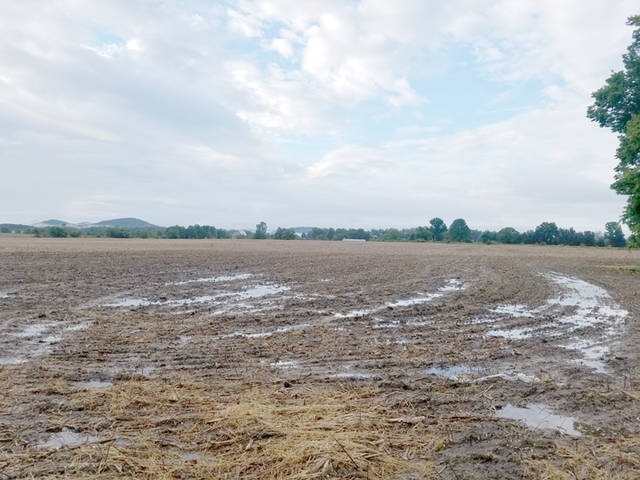By Wayne Gates
2018 and 2019 may end up as two of the wettest consecutive years since 1871.
According to the National Weather Service, 90 inches of rain has fallen in our area between January1, 2018 and June 19, 2019.
2018 had the third highest rainfall ever recorded, with 55.90 inches. So far this year, 33.72 inches have fallen. 2011 holds the record for rainfall with 73.28 total inches.
All of that rain has made for very tough times for local farmers. Many acres have not been planted. Those that have been are seeing water damage, pests and other problems eating away at the crops.
Hay can’t be harvested in these conditions either. That means with less hay and feed corn available, livestock producers will pay more to feed their herds. Those higher costs will very likely be passed on to meat consumers at the grocery store.
Ohio State University Agriculture and Natural Resources Educator James Morris said that local farmers are suffering in many ways from the relentless rain.
“This rain is creating a lot of stress, productivity wise and also financially for farmers in Brown County. This is one of the most challenging years since the drought of 2012,” Morris said.
“I think we are going to have a significant reduction in the amount of acres planted and a big drop in production. The total number of bushels we are going to pull out of Brown County is going to be significantly lower this year.”
Morris said that the normal acreage now planted in the county is way down.
“We are very far behind on our normal schedules. According to the USDA Crop Progress Report for corn, this week we are at 68 percent of corn planted. Last year we were at 100 percent at this time,” Morris said. “For soybeans, we are at 46 percent planted, with last years numbers and the five year average being 94 percent.”
Morris said that the calendar was is now a huge factor in the decision making for local farmers.
“June 5 was the crop insurance deadline to get corn planted, with farmers losing one percent of the insurance a day until June 25. After that, crop insurance is not an option for them,” he said.
Morris added that the crop insurance deadline for soybeans was June 20, with July 15 as the latest it can be planted while losing one percent a day.
“The weather this week has obviously not been favorable. By the time things dry out and we can get anything into the ground, a lot of time is going to pass with that July 15 deadline getting closer,” he said.
If farmers choose not to plant they can take what Morris called Preventive Planting insurance coverage, which brings about 55-60 percent of the revenue for a normal crop.
“From conversations I have had with local farmers, a lot of them are choosing the Preventive Planting option,” he said.
For those farmers who have actually managed to plant this year, Morris said they have a fight on their hands.
“As we stress these plants early on, that opens the door for disease, insect damage and stuff like that. We are already seeing soybeans having disease problems this early in the year because of the wet conditions. Not only that, but we are looking at root rot problems to affect the yield later in the year.”
One area of financial relief for farmers might be the Market Facilitation Payments from the USDA, which are designed to soften the potential impact of retaliatory tariffs on U.S. crops from foreign countries, especially China.
“There will be payments made, we just don’t know exactly how those will be organized and what those amounts will be.” Morris said.
Morris said that some farmers also may choose the option of planting oats in August and harvesting them after November 1 to get some use out of their fields once things dry out.
Hay production is also an issue that has been greatly affected by the weather.
“This year, Ohio has the lowest hay inventory since 2012 and the fourth lowest in 70 years. That will drive hay prices higher, and the quality of the hay is also an issue because if you let it get too mature before you can harvest it, you lose a lot of the nutritional value in that hay,” Morris said.
“With a big drop in production, we are going to see a big change upward in grain prices, especially on corn. For the livestock industry, that’s going to raise feed prices.”
Morris expects those rising feed prices to be passed through the supply chain to consumers.

